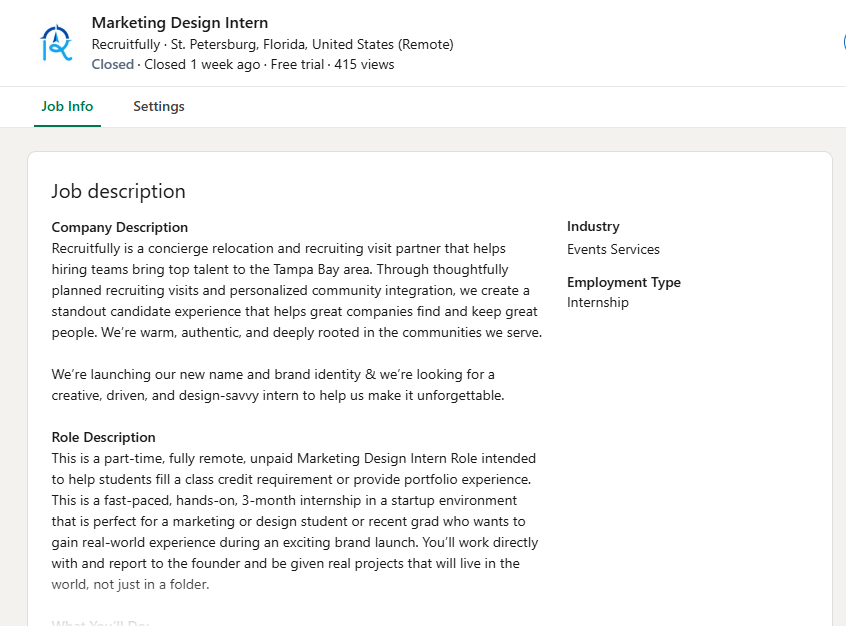Mini Case Study in Recruitment: Hiring Interns
At The Welcome Standard, we spend a lot of time thinking about recruitment and retention. Recently, I got the opportunity to dust off my recruiting hat and went through the process of hiring two marketing and design interns, and I wanted to share my approach as a niche case study. While this is just one example, some takeaways can be applied to broader hiring strategies, especially when it comes to interns and early-career talent.
Hiring Steps
To set the stage, here’s a snapshot of the internship I was hiring for:
Marketing Graphic Design Intern: 3-month internship for class credit or portfolio experience
Hands-on projects in brand relaunch, social media content, email templates, and welcome kits
Real deliverables that would live in the world, not just in a folder
Direct collaboration with the founder in a startup environment
Ideal for marketing/design students or recent grads looking for portfolio growth
Why It Was Appealing: The role promised not just observation but contribution. Interns would get real, portfolio-worthy experience with a new brand identity, plus mentorship and guidance


Step 1: Casting a Wide Net
I started by posting the role in two places: LinkedIn and Handshake. In 24 hours, the response was strikingly different:
LinkedIn: 74 applications
Handshake: 4 applications
Disclaimer: LinkedIn gave me a free 48-hour job post boost for this position. For some reason this perk hadn’t applied to my past postings, but it did here. I only kept the boost active for 24 hours, since 78 candidates was more than enough to work through. For me, this highlighted the importance of meeting talent where they already are. LinkedIn clearly had stronger traction for creative, design-oriented roles.
Step 2: Portfolio First
Because this was a graphic design/creative internship, portfolios were the single most important qualifier. Before moving anyone forward, I reviewed portfolio work (or disqualified if no portfolio link was provided) to ensure alignment with the role’s needs. This was a fast, effective way to prioritize candidates with both skill and style fit.
LinkedIn: 74 applications → 17 “good fits” identified & screener sent
Handshake: 4 applications → 1 “good fit” identified & screener sent
Step 3: Tailored Screener
For the candidates whose portfolios stood out, I sent a short Google Form screener (you can view the original here). It was a chance to understand how each person thought about design, collaboration, and working independently. It also gave another touch point for me to access the seriousness of the applicant, in some roles where you have limited applicants you want to minimize the hurdles, in this particular case where I had more than I needed it was a great refinement point to get to the serious and committed applicants.
LinkedIn: 74 applications → 17 “good fits” identified & screener sent → 8 screeners submitted → 6 interviews extended
Handshake: 4 applications → 1 “good fit” identified & screener sent → 0 screeners submitted → 0 interviews extended
Step 4: Structured Interviews
From there, I extended interview requests. To keep the process fair and unbiased, I used a scorecard method that graded candidates across categories like portfolio strength, creative process, social media understanding, coaching style, and overall fit. Each area was ranked on a consistent scale, which made it easier to compare candidates objectively. By the end, I interviewed four candidates, extended two offers, and had both accepted
LinkedIn: 74 applications → 17 “good fits” identified & screener sent → 8 screeners submitted → 6 interviews extended → 4 interviews scheduled and completed → 2 offers extended
Handshake: 4 applications → 1 “good fit” identified & screener sent → 0 screeners submitted → 0 interviews extended → 0 offers extended
What Made the Difference
Reflecting on the process, a few elements stand out as likely attractors for candidates:
Project-based structure: The internship wasn’t vague, it promised tangible projects and portfolio-ready work from day one. This gave applicants confidence their time would result in something to show for their time.
Clear timeline: A defined 12-week commitment made the opportunity approachable. Candidates knew exactly what they were signing up for, without fear of an indefinite unpaid role.
Brand launch excitement: Positioning the internship as tied to an exciting new brand launch made the role feel timely and special.
These factors combined to create a role that felt both valuable and respectful of student applicants’ time and goals. When I asked my interns for feedback on the selection, hiring, and onboarding process (which I believe is a very important step), here is what they shared:
“I applied because I was looking for a company with strong brand values and clear objectives for their intern. I’ve previously interviewed for other companies where it was difficult to understand what the company did or they simply wanted free design work before sending an offer letter. I appreciated that Tori emphasized collaboration and community, which are values that are also important to me in my professional career.”
“What stuck out to me the most about your job posting was the emphasis on gaining real world experience and coming out with portfolio pieces. I also was really drawn to the emphasis on celebrating community.”
Closing Thoughts
Hiring interns may not be the same as recruiting senior leadership or C-suite executives, but principles overlap. Clear criteria, a structured process, and a focus on authentic values can attract and engage the right talent at any level. For me, this experience reinforced that by treating even a short-term internship as an opportunity to welcome talent thoughtfully, we demonstrate what we believe at The Welcome Standard: great teams start with great welcomes

